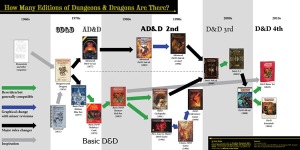So, for some blog fodder, I've decided I'm going to take on the rather ambitious project of going through every version of D&D and comment on the rules. To keep myself sane, I'll be sticking to core books only. I'm up in the air on OD&D if it will include the supplements or only the the original three LBB's. The idea is to hit up White Box, Holmes, Moldvay, Mentzer, Rules Cyclopedia, AD&D 1E, AD&D 2E, D&D 3/3.5, and 4E. And I'll probably have to get to Next if it's out by the time I get through all of the other stuff. Then, maybe I'll hit up the retroclones for the sake of comparison.
Now, I'm sure somebody's done something like this before, and I have read some "cover to cover" posts about specific editions, but my goal here is going to be to a) highlight the differences and think about why they are there, and b) identify those rules, tools, and ideas that are most useful to me for actual play, to aid me in kitbashing the Frankenstein's monster of a "perfect version" for my campaign. In large part, though, I just want to get to know the versions I'm not as personally familiar with (basically everything besides 2E and 4E). I expect it will take a while, but hopefully it will keep me gainfully blogging whenever I'm running short on ideas. First up will be the original three LBB's in the next post in the series.
Meanwhile, Fellhold Hex Stocking
(Using Welsh Piper's Regional Hex Template, with 5 mile sub hexes and heavily cribbed from Lore.Keeper0's Hex Crawl)
The lands around Fellhold are comparatively sparsely settled, so I'm going to modify the chances of an "outpost" (settlement type place) to be lower. I'll be running this for the regional hexes the players are currently traveling through first, and eventually flesh out the whole map.
For Each Regional Hex, determine the dominant terrain type (if you can't tell, just use the center hex). In the case of dual terrain (like wooded hills) go down this list in this order for precedence. Roll the appropriate die for the number of outposts/settlements in the regional hex. Then roll to determine size and inhabitants for each. Place as desired, or decide on a method to randomize placement:
Terrain Type | Number of Outposts | Size of Outposts | Inhabitants |
| Tundra/Glacier | 1d2 – 1 | Tiny (01-60) Small (61-00) | Dwarves (01-10) Men (11-00) |
| Mountains | 1d3 – 1 | Tiny (01-60) Small (61-89) Medium (90-00) | Trolls (01-40) Trollkin (41-80) Giants (81-90) Dwarves (91-95) Men (96-00) |
| Swamp/Fen | 1d2 – 1 | Tiny (01-70) Small (71-00) | Trolls (01-20) Trollkin (21-30) Men (31-00) |
| Forest | 1d3 – 1 | Tiny (01-50) Small (51-89) Medium (90-00) | Trollkin (01-30) Dwarves (31-35) Men (36-00) |
| Hills | 1d4 – 1 | Tiny (01-50) Small (51-80) Medium (81-90) Large (91-00) | Trollkin (01-30) Dwarves (31-50) Men (51-00) |
| Plains/Grassland | 1d6 – 1 | Tiny (01-50) Small (51-70) Medium (71-80) Large (81-00) | Dwarves (01-20) Men (21-00) |
Outposts
- Tiny: Individuals or very small groups, hermits, inns, mining/logging camps, homesteads
- Small: Villages, trading posts, forts
- Medium: Towns, keeps, market fairs
- Large: Cities, castles, fortresses, tribal encampments
Next, roll the number of adventuring sites per regional hex by dominant terrain type:
Terrain Type | Number of Adventuring Sites |
Tundra/Glacier | 2D4 |
Mountains | 2D6 |
Swamp/Fen | 2D6 |
Forest | 3D3 |
Hills | 3D3 |
Plains/Grassland | 2D4 |
Adventuring Sites
Adventuring sites are ruins, monster lairs, encounters, and so forth. Detail as you like or use a cool random generator. Abulafia has lots of great stuff.

No comments:
Post a Comment